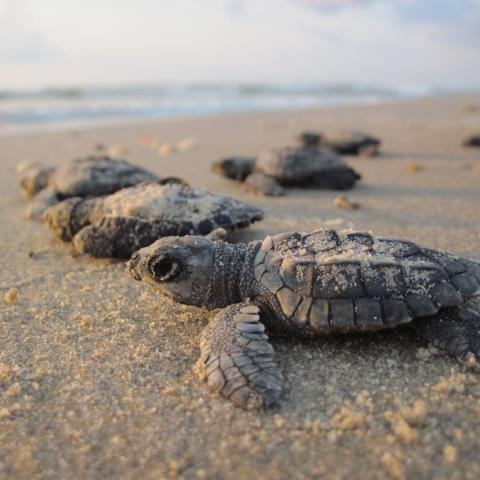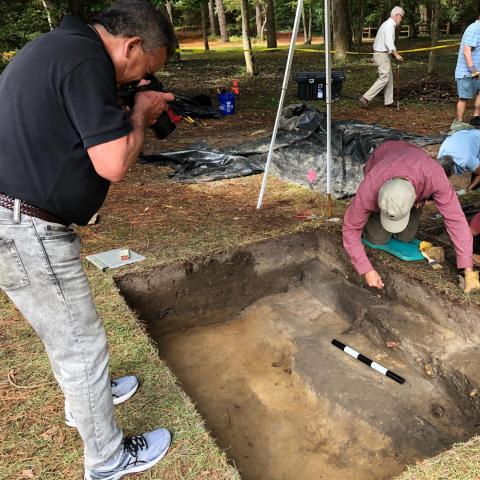A new off-road vehicle ramp is being built at Cape Hatteras National Seashore, which called for more vehicle beach access in its Off-Road Vehicle Management Plan.
Seashore Superintendent David Hallac said that VRHabilis, LLC, of Knoxville, Tennessee, has begun the ramp construction project. The new ramp will be located approximately 3 miles south of the ferry dock at the north end of Ocracoke Island, North Carolina. The project, funded with ORV fee monies, marks the continuation of several proposed construction projects to facilitate beach access for the public.
VRHabilis will construct the ramp by creating a gentle slope for ORV traffic from Highway 12 to the beach front, while maintaining a crest height similar to the existing dune landscape. The grading project will be followed by National Park Service employees surfacing the ramp with a shell and clay mixture.
The ramp is expected to be open for public use by the end of spring. For public safety, entry into the construction area is prohibited until construction is complete.




 Support Essential Coverage of Essential Places
Support Essential Coverage of Essential Places







Comments
Whatever happened to feet? You know, those things at the lower end of our legs. Why must park visitors ride four-wheel motocycles across the beach dunes instead of slowly walking and observing the wonders of the beach and near shore waters? Yes, I understand that some may not be able to walk, but they can be accommodated without throwing open the doors to ATVs. I will soon be 80 yrs. old. I am slowing down - but I try to compensate and get more from less. it works.
Ray, it goes back to around 2007 when things got pretty ugly at Cape Hatteras over efforts to craft an ORV Management Plan, as required by President Nixon but which had never been done at the Cape.
There was tremendous pressure from the surf casting community that they needed to be able to use their trucks to haul all their fishing gear, coolers, food, etc, to their favorite places on the beaches for fishing. Some entailed more than a mile of travel on the beach, I believe.
Part of the negotiated settlement called for the Park Service to add some beach access ramps.
We've written a great deal about it. Here are some of the stories:
http://www.nationalparkstraveler.com/2011/08/cape-hatteras-national-seas...
http://www.nationalparkstraveler.com/2011/08/cape-hatteras-national-seas...
http://www.nationalparkstraveler.com/2011/02/north-carolina-politicians-...
http://www.nationalparkstraveler.com/2010/11/conservation-groups-questio...
http://www.nationalparkstraveler.com/2010/08/district-court-upholds-desi...
http://www.nationalparkstraveler.com/2012/02/cape-hatteras-national-seas...
http://www.nationalparkstraveler.com/2012/02/orv-group-files-lawsuit-ove...
Thanks for the background information, Kurt. It helps to clarify the access issues specific to Cape Hatteras. However, my concern re: ATV/ORV access on conservation lands, particularly national parks, goes far beyond the cape. Off-road vehicles are spreading like mechanical fire ants across the country invading parks and other conservation units wreaking havoc with fragile lands from Florida to Alaska - including designated wilderness areas. The Sierra Club and Alaska Conservation Foundation jointly commissioned a study of ORV concerns in Alaska in 2000. The resulting report, "Shredded Wildlands", revealed varying degrees of ORV damage, some severe and widespread, taking place in virtually every federal and state concervation unit in the Alaska. This included long-established national parks (Glacier Bay, Denali, Katmai, etc.) as well as wildlife refuges and national forests. In virtually all affected areas damage to lands and resources, including archeological sites, is on-going and expanding. Indeed, it seemed that responsible managing agencies, including the NPS, had literally gone into retreat before the pressures of ATV forces, including in areas where there is no legal justification for the use of ATVs on conservation lands. ATV/ORV technology is constantly evolving producing increasingly powerful and versitile machines able to claw their way over and across lands once considered too difficult for mechanical vehicles. Once the use of these machines is allowed within conservation units it is increasingly difficult to limit their impacts.